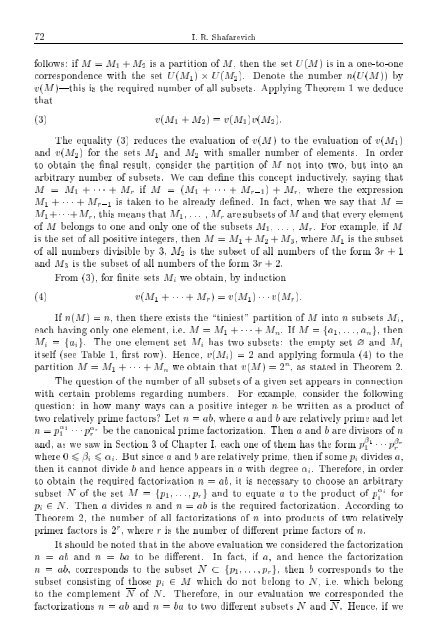SELECTED CHAPTERS FROM ALGEBRA I. R. Shafarevich Preface
SELECTED CHAPTERS FROM ALGEBRA I. R. Shafarevich Preface
SELECTED CHAPTERS FROM ALGEBRA I. R. Shafarevich Preface
You also want an ePaper? Increase the reach of your titles
YUMPU automatically turns print PDFs into web optimized ePapers that Google loves.
72 I. R. <strong>Shafarevich</strong>follows: if M = M 1 + M 2 is a partition of M, thenthesetU(M) isinaone-to-onecorrespondence with the set U(M 1 ) U(M 2 ). Denote the number n(U(M)) byv(M)|this is the required number of all subsets. Applying Theorem 1 we deducethat(3) v(M 1 + M 2 )=v(M 1 )v(M 2 ):The equality (3) reduces the evaluation of v(M) to the evaluation of v(M 1 )and v(M 2 ) for the sets M 1 and M 2 with smaller number of elements. In orderto obtain the nal result, consider the partition of M not into two, but into anarbitrary number of subsets. We can dene this concept inductively, saying thatM = M 1 + + M r if M = (M 1 + + M r;1 )+M r , where the expressionM 1 + + M r;1 is taken to be already dened. In fact, when we say that M =M 1 ++M r , this means that M 1 ,...,M r are subsets of M and that every elementof M belongs to one and only one of the subsets M 1 , ... , M r . For example, if Mis the set of all positive integers, then M = M 1 + M 2 + M 3 , where M 1 is the subsetof all numbers divisible by 3,M 2 is the subset of all numbers of the form 3r +1and M 3 is the subset of all numbers of the form 3r +2.From (3), for nite sets M i we obtain, by induction(4) v(M 1 + + M r )=v(M 1 ) v(M r ):If n(M) =n, then there exists the \tiniest" partition of M into n subsets M i ,each having only one element, i.e. M = M 1 + + M n . If M = fa 1 ...a n g,thenM i = fa i g. The one element set M i has two subsets: the empty set ? and M iitself (see Table 1, rst row). Hence, v(M i )=2and applying formula (4) to thepartition M = M 1 + + M n weobtainthatv(M) =2 n , as stated in Theorem 2.The question of the number of all subsets of a given set appears in connectionwith certain problems regarding numbers. For example, consider the followingquestion: in how many ways can a positive integer n be written as a product oftwo relatively prime factors? Let n = ab, wherea and b are relatively prime and letn = p 11 pr rbe the canonical prime factorization. Then a and b are divisors of nand, as we saw in Section 3 of Chapter I, each one of them has the form p 11 pr rwhere 0 6 i 6 i . But since a and b are relatively prime, then if some p i divides a,then it cannot divide b and hence appears in a with degree i . Therefore, in orderto obtain the required factorization n = ab, it is necessary to choose an arbitrarysubset N of the set M = fp 1 ...p r g and to equate a to the product of p iiforp i 2 N. Then a divides n and n = ab is the required factorization. According toTheorem 2, the number of all factorizations of n into products of two relativelyprimer factors is 2 r ,wherer is the number of dierent prime factors of n.It should be noted that in the above evaluation we considered the factorizationn = ab and n = ba to be dierent. In fact, if a, and hence the factorizationn = ab, corresponds to the subset N fp 1 ...p r g, then b corresponds to thesubset consisting of those p i 2 M which do not belong to N, i.e. which belongto the complement N of N. Therefore, in our evaluation we corresponded thefactorizations n = ab and n = ba to two dierent subsets N and N. Hence, if we
















